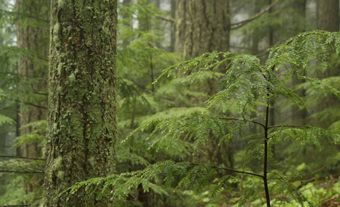
Forestry is the science and practice of caring for forests. Both the meaning and practice of forestry in Canada have evolved over time. In the first half of the 20th century, forestry referred almost exclusively to the management of wooded tracts of land for industrial use. Following the Second World War, managing woodlands on a sustainable basis increased in importance, and by the 1960s, the extent to which forestry incorporated ecological considerations was unprecedented. By the turn of the 21st century, forestry activities had expanded further still, including caring for trees in urban settings. (See also Timber Trade History; Forest Harvesting; Lumber and Wood Industries; Pulp and Paper Industry; Reforestation.)
Background
About 38 percent of Canada’s land area is forested, or about 3.4 million out of 9.1 million km2. Slightly more than half of this area is classified as commercial forest capable of producing merchantable trees in a reasonable length of time, and has not been reserved for other uses such as parks.

Most Canadian forest land is owned and administered by either the provincial or federal government and is thus referred to as Crown forest. The British North America Act of 1867 assigned jurisdiction for forests to the provincial governments regardless of when each joined Confederation. There were a few exceptions to this rule, however. Until 1930, the federal government retained authority over the forests of Manitoba, Saskatchewan and Alberta and the 64 km-wide railway belt along the route of the Canadian Pacific Railway in British Columbia. Today, provincial and territorial governments are responsible for about 90 percent of the non-reserved commercial forest land, the federal government controls roughly 2 percent (this includes First Nations reserves, military bases and national parks), and private owners oversee the remaining 8 percent. In some instances, provincial governments — and sometimes the federal government — have supported forestry on private lands through a variety of instruments including tax incentives and regulatory policies. Finally, nearly every province and territory has a forestry agency, usually a branch or service located within a ministry charged with responsibility for natural resources.
The fact that governments have had jurisdiction over nearly all the commercial timberlands in Canada has had a profound influence on the manner in which forestry has been practised. From the outset, foresters called for the woods to be managed prudently. This approach entailed both improving the efficiency with which trees were harvested and investing in regenerating them to ensure that the forest’s productivity would be sustained forever. A problem arose, however, due to a marked lack of political will to support the latter activity. In the eyes of elected officials, whose terms lasted a mere four years, there was little point in spending precious public resources on reforestation when the returns on investment would not be seen until decades after they had left office. In this regard, the politicians were simply reflecting the wishes of most Canadians, who, for the longest time, did not insist that their governments be good stewards of their woodlands.
History
Forestry’s Pioneering Years: ca. 1900–40
The forestry profession was born and developed in Europe during the first part of the 19th century. It owed its genesis to a widespread realization that short-sighted harvesting practices had deforested major parts of the continent and created a string of environmental issues. This realization, combined with an acute awareness of Europe’s relatively small land base, fostered strong public and political support for forestry principles, which were embraced in an effort to rectify the situation. In this context, forestry ranked alongside other professions — such as medicine and dentistry — in terms of social stature.
When forestry arrived in Canada around the turn of the 20th century, it was transplanted into a very different social setting than the one in Europe. By this time, Canadians had come to value certain professions, such as engineering, for their relatively immediate and practical contributions to society. Engineers enjoyed a privileged status, and efforts were made to train more in the field.
The situation was the opposite for forestry. There had been calls for the woodlands in Canada to be managed in a more effective manner, but there was hardly widespread political or public support for full-fledged forest management. People struggled with the concept of spending money in the present in order to realize long-term gains. This meant that the handful of foresters who began practising their profession in Canada in the early 1900s lacked the social legitimacy that their brethren in Europe enjoyed. This disparity lingered for decades.
Despite these challenges, Canadian forestry had its beginnings in the early 20th century. Canada’s first forestry school was established at the University of Toronto in 1907. Over the next few years, the second was created at the University of New Brunswick and the third at Laval University in Québec City (the forestry school at the University of British Columbia would open its doors in 1921). By this time, the country’s proponents of forestry had formed the Canadian Forestry Association (est. 1900) to publicize the need for forest conservation and the Canadian Institute of Forestry (est. 1908) to give forest practitioners a forum for discussing the issues they faced.

From roughly 1900 to 1940, the number of foresters grew dramatically in Canada, but they were able to make relatively little headway in terms of improving how the country’s woodlands were managed. The forest industry had long been a mainstay in the Canadian economy; during this period it was concentrated in the Maritimes, Ontario, Québec and British Columbia. It consisted of lumber makers (they turned relatively large-diameter trees into building materials) and pulp and paper producers (they transformed generally small-diameter trees into things such as newsprint and book paper), located across the country. They leased their woodlands from provincial governments. Although a few of them showed interest in investing in implementing forestry programs on their woodlands, they often argued that they were reluctant to do so because of the tenuous nature of their control over their timber supplies. Similarly, provincial governments showed little inclination to compel the firms to practise sound forestry.
This period did, however, see forestry expand its realm of operations. This included undertaking forest research, led by Ottawa through its Dominion Forest Service (established at the turn of the century). It and other branches of government investigated a wide gamut of subjects, including the insects and diseases that were attacking Canada’s trees and the means by which they could be combatted.
Forestry’s Golden Era: 1940–70
In the middle of the 20th century, Canada’s forest industries enjoyed an unprecedented boom — a time period often referred to as the golden era. The world’s appetite for wood products — everything from construction lumber to toilet paper — exploded. Existing facilities expanded, and new ones were established in places with little industrial forestry, such as Alberta and Saskatchewan. In addition, the country began producing new products (e.g., oriented strand board). This success did not, however, translate into meaningful support for regenerating the commercial woodlands.
This extraordinary growth increased the demand for foresters to oversee the harvesting and procurement of wood needed to supply mills and plants. The ranks of foresters expanded, and enrolment at the country’s existing forestry schools rose to meet this demand. In addition, two new forestry schools were established in the early 1970s, one at Lakehead University, in Thunder Bay, Ontario, and the other in Edmonton, at the University of Alberta.

Technological advances occurred in nearly every aspect of foresters’ work. While aircraft had been introduced to forestry during the 1920s, specifically for spotting and fighting forest fires and carrying out forest inventories, the development of ever more sophisticated aerial photography equipment during and after the Second World War greatly improved the information foresters gained about the trees they were managing. Specialized planes were also developed for fighting forest fires, a field in which Canada became a world leader. Furthermore, foresters increasingly adapted computers to their work, allowing them to analyze larger sets of data concerning things such as the rate at which forests grow. Steps were also taken, principally by the federal government, to improve the research that was being conducted into the nature of the country’s trees. This included establishing several new facilities across Canada’s different forest regions.
Forestry also branched out into new activities during these years. Trees had long been part of urban landscapes, but during the 1960s, caring for them emerged as a sub-field of the profession. This was due largely to the devastating toll Dutch elm disease was taking in the early 1960s on the stately trees that dominated the largest cities in southern Ontario. Erik Jorgensen, a forest pathology professor at the University of Toronto’s faculty of forestry, spearheaded an effort to combat the menace. Largely due to Jorgensen’s efforts, by the end of the decade the world’s foresters had come to recognize urban forestry as a bona fide specialization.
The country’s foresters also faced new challenges in their work. Canadians enjoyed more disposable income and leisure time after the Second World War and began demanding that larger portions of the forest be set aside for recreational pursuits. Closely related to this movement was the rise of an environmental consciousness among Canadians. Its more radical exponents unleashed a barrage of criticism against industrial forestry, specifically because of its focus on extraction instead of stewardship. It was ironic timing: at the same moment that Canadians were beginning to support foresters in their long-sought-after environmental initiatives, forestry was also becoming one of the most stigmatized professions in the country.
Forestry Under Siege: 1970–Present
Since the dawn of the environmental movement in the 1960s, the forestry profession has endeavoured to defend itself against attacks from environmentalists. These efforts, however, have met with mixed success. Since at least the 1970s, forestry practices in Canada have improved dramatically; many provinces oblige those who harvest timber on Crown lands to adhere to some of the most rigid environmental standards in the world. Nevertheless, the criticism of logging that began in the 1960s intensified over the next few decades. For example, the protest against harvesting in the Clayoquot Sound watershed on the west coast of Vancouver Island in the early 1990s is said to have been the largest act of civil disobedience in Canadian history. Although the frequency of such campaigns has diminished in the 21st century, they continue. Moreover, in the new millennium, Canada’s forest industry suffered from a new set of challenges that resulted in a long list of mill closures and lost jobs. Predictably, forestry’s allure as a profession has declined, as has the number of foresters in Canada.

Insects also pose a challenge to forestry. Introduced insects, such the emerald ash borer from Asia, have decimated a number of ash species in Canada in the 21st century, particularly in urban environments. Likewise, some native “pests”, such as the mountain pine beetle, have thrived under the conditions resulting from climate change and human suppression of fire in the forest.

 Share on Facebook
Share on Facebook Share on X
Share on X Share by Email
Share by Email Share on Google Classroom
Share on Google Classroom



